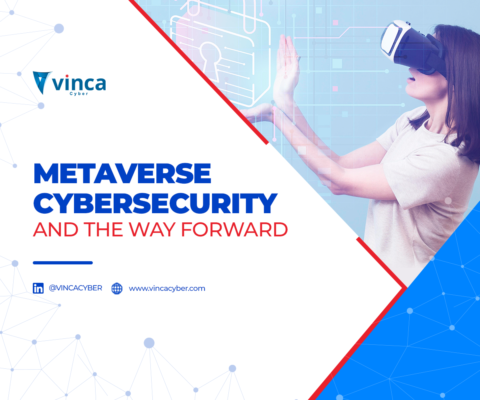The word “metaverse” is trending across the globe, with a major hype around digital twins (avatar), virtual world, VR (Virtual reality), AR (Augmented reality), ML (Mixed reality) etc. We at Vinca Cyber are also excited about the metaverse, but with a commitment to ensure a cyber-secure metaverse for every business.
In this article, we will discuss our security experts’ perspectives on the metaverse, metaverse cybersecurity, and the way forward.
Metaverse
Imagine you are present in two different meetings at the same time but in distinct places. This is a meta + verse (self-version) that has been garnering so much attention. It is all about leveraging the internet and other technologies to live and work in a 3D-enabled virtual world.
We are already harnessing one of the metaverse components, VR (Virtual Reality). The only difference is that when we plug out our VR glasses and headsets, we are out of the virtual world but in the metaverse, our digital twin stays active and can perform all actions on their own.
For cybersecurity experts, this is the biggest source of concern because, in our current environment, human-made errors are the leading cause of security breaches, and if this extends to the virtual world, a flood of uncontrolled security hijacks can counter every possible good outcome with way more critical threats.
Metaverse cybersecurity
As navigating to the metaverse will bring a 3D-Internet reality in which users will be able to interact with and explore multiple things far more advanced and immersive than current VR applications.
Its privacy and data security are the biggest cyber security concerns. To mitigate such threats in the metaverse there is a need for advanced cybersecurity policies, compliance, regulations and practices that can enhance benefits and offer safe and secure use cases.
Let’s have a look at some of the crucial checklists to ensure metaverse cybersecurity:
Avatar Kidnaps
As in the metaverse, a user avatar (digital twin) stays active even when the actual user is not active. There can be incidents where dormant or active avatars can be captured by cyber criminals, which may require organizations or individuals to pay a heavy ransom amount.
Avatar kidnap (identity kidnap) becomes a critical challenge because if data associated with an identity is exposed, it not only harms that identity but, due to virtual connectivity, it can become a source of mass metaverse exploitation, raising a big question to the long-term sustainability of the metaverse model.
Metaverse hardware security
To connect the metaverse with the physical world, hardware devices like smart glasses, VR headsets, and ML sensors are really important as these work as a bridge. If by any chance the security of these devices gets compromised, these devices will become attack vectors to enter the metaverse world.
Therefore, organizations need to ensure high-grade security and policies to monitor safe connectivity between physical and metaverse reality.
Metaverse ownership
Unlike a simple VR system, in the metaverse, a user has complete ownership of their information, which is critical because ownership without knowledge of security becomes similar to treasury without the lock.
That’s why it’s necessary to balance privacy and ownership in the right way to meet necessary compliance and regulations to ensure a user can’t become a self-victim of criminal activities.
Monopoly issues
As the metaverse is currently in development, it is a high-investment aspect that is limited to a few tech-rich companies, implying that if there were no clear policies, it would be like a user with all privileges but in a lock-up.
Hence, there is a need for the implementation of cybersecurity policies to safeguard user rights and encrypt activities in the metaverse.
Way forward
No doubt, the metaverse is trending and expanding by the day, however, implementing the right cybersecurity policies, tools, and regulations is a mandate for a safe, secure, and sustainable metaverse world.
Vinca Cyber is committed to ensuring our partners get this to the next step right by offering proactive robust and agile digital security infrastructure.

